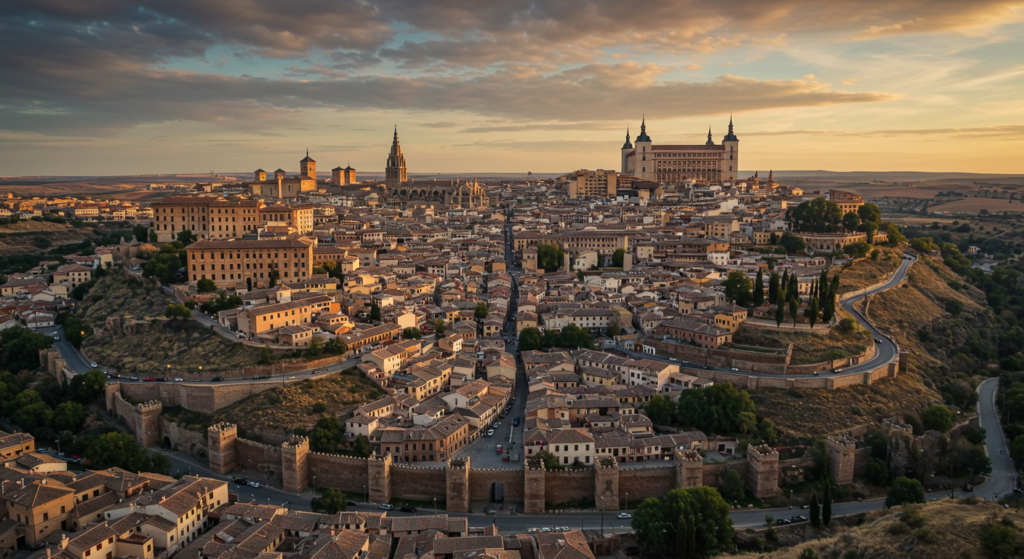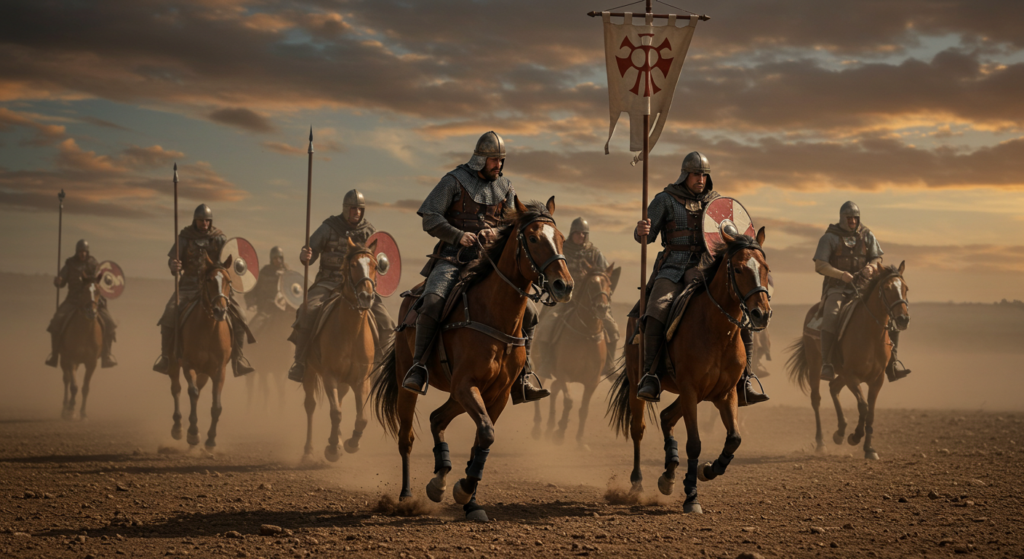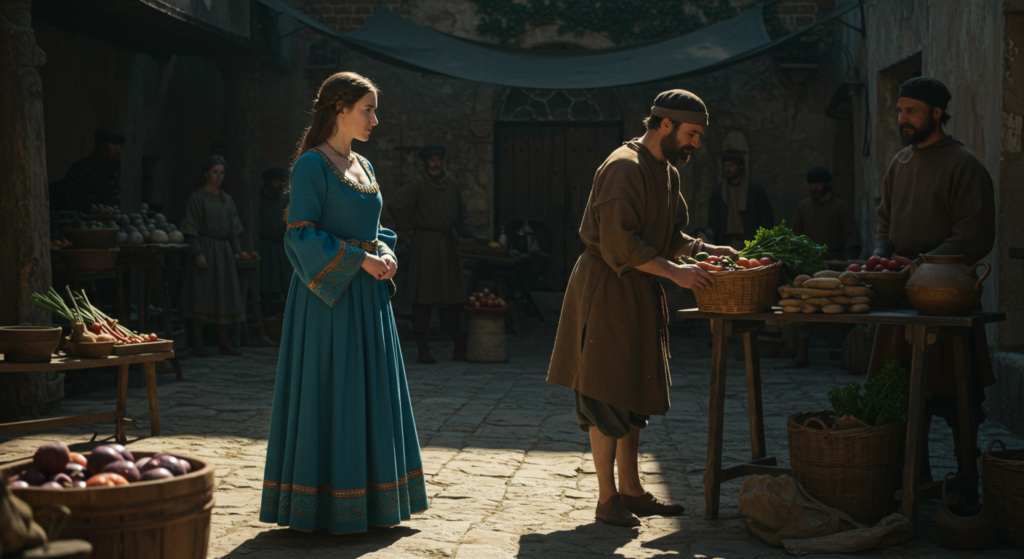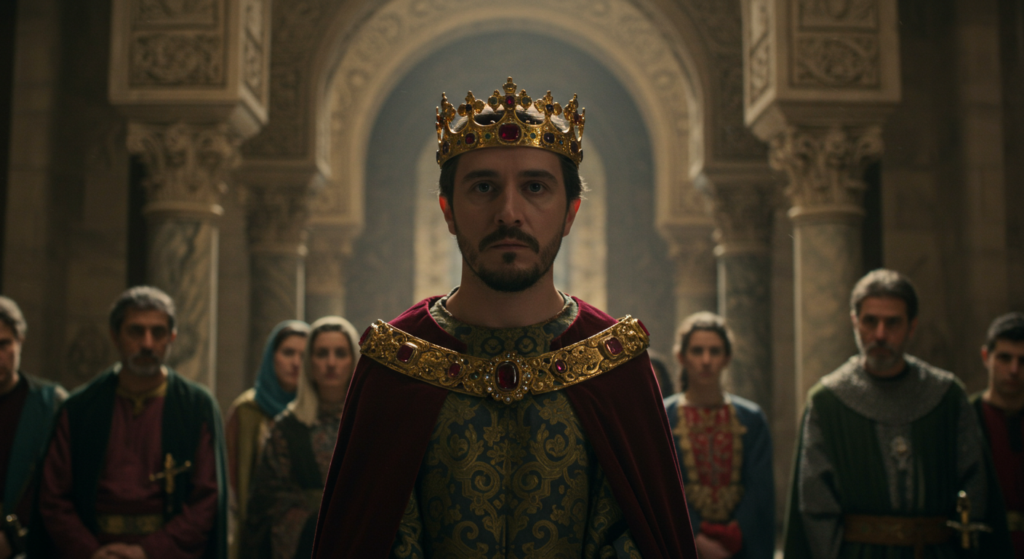Key Takeaways
- The Visigoths emerged from Gothic tribes that migrated across Europe, shaping a realm on the Iberian Peninsula.
- They blended Roman institutions, local Iberian cultures, and their own Gothic customs into a unique society.
- Gold crowns became symbols of status and power, reflecting bright artistry in royal settings.
- Iberian sunsets and varied landscapes offered color influences for architecture, mosaic floors, and courtly fashion.
- This kingdom bridged old Roman legacies with medieval developments, leaving an enduring mark on European history.
- Understanding their politics, everyday life, and fascination with color gives modern readers a fresh perspective on their heritage.
Introduction

Western Europe of late antiquity saw many groups competing for land and influence. Out of those came the Visigoths, who claimed a vast portion of the Iberian Peninsula after Rome’s authority weakened. Their story features political turns, intermarriage with local populations, and alliances with powerful neighbors.
How did they govern? Why did gold crowns gleam on Visigothic monarchs, and how did the palette of the peninsula affect their art forms? This post dives into those questions. You’ll see how color, climate, and shifting alliances shaped a kingdom both Gothic and Iberian. We’ll explore royal assemblies, farmland scenes, and subtle elements of daily life.
If you’ve ever wondered about the legacy of the Visigoths and how they merged their Gothic roots with the vibrant land they ruled, this guide will feed your curiosity. Let’s step into the realm of Gothic crowns, Iberian sunsets, and a people often overlooked in mainstream history. Their story spans conquests, crafts, trade, and faith, all under golden skies.
Early Footsteps in Europe

Setting the Stage
Before conquering Iberia, the Visigoths started as a branch of the larger Gothic world. They wandered across lands once held by Rome, searching for opportunities. They roamed from the Danube region toward Italy, then over to Gaul. In those journeys, they absorbed Roman customs and met new peoples. These early encounters led them to form alliances, pick up Latin words, and adjust to new farmland and climates.
Relationships with Rome
Rome treated them as both allies and threats. The empire recruited Gothic warriors to bolster legions, yet mistrusted them as outsiders. Over time, these warriors discovered Roman political tactics. Some learned advanced military engineering. Others studied Roman organizational methods. When the empire’s structure weakened, the Visigoths used their blend of knowledge to carve out a place of their own.
Ties to Other Germanic Tribes
Visigoths interacted with Vandals, Suebi, and Ostrogoths. They sometimes cooperated, but more often they fought for resources. Each group had different beliefs, dialects, and ways of governing. By forging alliances or defeating rivals, the Visigoths forged a unique identity. Their journey across Europe set the tone for the kingdom they would build in Iberia, where influences mixed into something distinct.
Arrival in Iberia

Crossing the Pyrenees
The Pyrenees Mountains separated Gaul from the Iberian Peninsula. The Visigoths, led by their kings, made that crossing after years of living in southern Gaul. They saw the peninsula’s fertile valleys and warmer climate as prime real estate for a stable realm. That crossing also opened them to new trade routes. Seaports, farmland, and mineral resources were attractive prizes.
First Impressions of the Land
Arriving in Iberia meant encounters with old Roman villas, coastal towns, and local tribes. The land offered varied landscapes—rocky coasts along the Atlantic, rolling plains in the center, and sunny vistas near the Mediterranean. These views helped shape Visigothic art. They adopted bright pigments when decorating churches and official buildings.
Establishing a Foothold
They had to deal with rivals like the Suebi in the northwest and pockets of Roman administration along the coast. To secure territory, Visigothic kings split land among loyal followers. Others formed pacts with local elites. The royal court recognized that a stable base would require acceptance by local populations, so they let certain areas retain their customs while adopting partial Gothic rules.
The Rise of a Kingdom

Power Consolidation
Over time, the Visigothic court moved from simple raiding operations to structured governance. They set up councils that enacted laws, blending Roman legal traditions with Gothic rules. The monarchy depended on loyalty from noble families, who each received farmland and local power. These networks allowed the kingdom to withstand outside threats.
Shifting Capitals
Cities like Toulouse (in Gaul) served as early seats of power, but pressure from the Franks pushed the Visigoths farther into Iberia. Toledo, with its central location, rose as a favored capital. This new political center gave them a strategic vantage point, bridging northern mountains and southern coasts. Toledo also became a cultural hub where scribes copied texts, and goldsmiths crafted regal pieces.
Growth of Royal Authority
Visigothic kings used religious connections, alliances with bishops, and strong military leadership to reinforce authority. They promoted themselves as defenders of Christian faith, which appealed to local communities. Synods of Toledo, gatherings of bishops and nobles, also boosted royal prestige. Kings wore gold crowns studded with jewels, a bold display of power that merged Gothic style with Iberian artistry.
Noble Life and Warfare

Armor and Weaponry
Noble warriors fought on horseback with heavy cavalry tactics learned from Roman legions. Leather and metal plates offered protection. Swords featured patterns hammered into steel. The Visigoths valued these items, sometimes passing armor down generations. Colors on shields ranged from deep blues to earthy reds, reflecting either clan emblems or personal tastes.
Castles and Fortifications
Some local strongholds blended Roman walls with new Gothic additions. Nobles built fortified manors on high ground. They used thick stone and towers to spot enemies from a distance. These forts controlled roads and farmland, ensuring a steady supply of grain. They also served as safe spots during raids or local disputes.
Hunting and Leisure
Away from wars, nobles enjoyed hunts in wooded areas. They chased wild boars and deer, bringing them back for feasts. These events showcased rank and skill. Hunting outfits might feature dark cloaks, subtle embroidery, and sturdy leather boots. Social gatherings let them trade news, forge alliances, and even arrange marriages.
Common Folks and Rural Scenes

Fields and Harvest
Most people worked the land. Wheat, barley, and olives thrived under Iberian sun. Villagers irrigated fields, relying on local streams or improvised channels. They harvested crops in late summer, bundling stalks in large sheaves. Children and elders helped glean leftover grain. These cycles of sowing and reaping anchored rural life across the kingdom.
Village Crafts and Markets
Small workshops produced pots, textiles, and wooden utensils. Clay pots came in muted shades of brown or gray. Weavers made plain tunics for daily wear. Markets were lively centers where farmers traded surplus crops for salt, pottery, or fish from distant coasts. A traveling merchant might carry bright cloth or foreign trinkets from far-off regions.
Seasonal Festivals
Communities enjoyed feast days around planting or harvest. They sang folk tunes and lit communal fires. Bright ribbons decorated common areas to celebrate a good yield. Some festivals merged old pagan roots with Christian observances. Over time, these events shaped local identity and gave villagers a sense of unity despite different backgrounds.
Art and Colorful Expressions

Mosaics and Wall Paintings
Roman influence lingered in mosaic artistry. Skilled artisans assembled tiles into detailed images of animals, geometric shapes, and biblical scenes. Deep reds and shimmering gold pieces evoked majesty. Wall paintings in churches relied on chalky pigments for saints’ robes or heavenly backgrounds. Many scenes took inspiration from local landscapes, capturing sunsets or rugged hills.
Goldsmithing and Jewelry
Gothic gold crowns became icons of Visigothic royalty. Artisans shaped gold sheets, set them with polished stones, and engraved intricate motifs. Noble families commissioned rings and brooches with swirling patterns, blending Gothic lines and Iberian flair. In Toledo’s workshops, goldsmiths used raw gold from local mines and recycled Roman coins, repurposing them into crowns that glistened in candlelight.
Illuminated Manuscripts
Scribes in monastic communities copied texts on parchment. They added decorative initials in bright pigments. Deep blues or burnished gold leaf highlighted important passages. Although the style had ties to earlier Roman manuscripts, the Visigoths developed their own look. Floral borders, braided lines, and cross motifs appeared in the margins, reflecting local traditions and religious devotion.
Faith and Religious Customs

Conversion to Catholicism
Initially, many Visigoths followed Arian Christianity, a version that differed from the Nicene Creed. Over time, political needs and alliances with local Hispano-Roman bishops led Visigothic kings to adopt Catholic Orthodoxy. This shift reduced conflict with the majority population. It also aligned the throne with influential church figures, who helped shape moral rules and social norms.
Monastic Life
Monasteries dotted the countryside, offering quiet places for prayer and study. Monks farmed, copied religious texts, and tended to travelers in need of shelter. They might use local dyes to color robes in plain tones, as a sign of humility. These institutions played a big role in preserving knowledge, even during times of turmoil.
Church Architecture
Visigothic churches combined Roman basilica layouts with new design elements. Arches showed a heavier feel, sometimes with thick columns and carved capitals. Interiors might feature wall paintings or simple mosaics. Altars often displayed gold or gilded objects, reflecting a mix of Gothic extravagance and local influences. Light streamed through small windows, illuminating the colors of frescoes.
Trade Networks and Commerce

Local Exchanges
Internal markets thrived on the movement of cereal grains, olive oil, wine, and salted fish. People traveled by cart over rough roads connecting villages to regional trade hubs. Goods sometimes passed through rivers, making shipping more efficient. These daily exchanges gave the kingdom a sense of interlinked communities.
Ports and Coastal Routes
Harbors along the Mediterranean and Atlantic coasts saw ships from North Africa and the eastern Mediterranean. They brought spices, glassware, and textiles. In turn, Iberian exports included metal ores and surplus produce. Coastal towns grew wealthy from maritime traffic. Buyers admired the shining gold filigree from local smiths, turning it into a prized import beyond the peninsula.
Connections to the East
Visigothic traders sometimes ventured into routes once controlled by Romans. They exchanged silver, iron, or even slaves. The kingdom never matched the scale of the old empire’s trade, yet it maintained a decent network. Exotic pigments or color-rich fabrics sometimes passed through Iberia, sparking fresh styles in royal courts.
Language and Writing

Latin and Gothic Influences
Latin remained the main written language, thanks to the legacy of Rome and its widespread use in administration. However, everyday speech could blend local Romance dialects with a few leftover Gothic terms. Nobles often spoke both, ensuring they could interact with Romanized populations and fellow Goths.
Educational Centers
Bishops and scholars taught reading and writing in church schools. Many students learned to copy religious texts, recite prayers, and produce official letters. In certain monasteries, teachers introduced classical Roman works, preserving that heritage. Over time, fresh scribal styles emerged, marked by cursive strokes and small flourishes.
Documents and Laws
Kings oversaw legal codes that merged Roman law with old Germanic practices. These codes were written in Latin. They outlined property rights, punishments for theft, and guidelines on inheritance. Such documents helped shape the kingdom’s structure, giving local magistrates a reference for settling disputes and clarifying the roles of free folk and slaves.
Clothing and Personal Style

Everyday Garb
Common folks wore basic tunics or dresses made from linen or wool. Earthy tones prevailed: browns, tans, and faded greens. A belt around the waist kept clothing in place. Shoes were often leather sandals or simple wraps, suited for fields and narrow roads. Such outfits were practical and easy to mend.
Noble Fashion
Wealthy individuals favored finer fabrics. Imported silk from the East showed up in royal courts. Tunics might feature embroidered bands. Cloaks were fastened with decorative brooches. Women wore veils or scarves in bright hues—reds and blues were popular. Men sometimes sported short capes lined with fur in colder seasons, showcasing status and taste.
Colorful Accents
Dyes from local plants gave glimpses of vibrant color. Madder root produced reds, woad gave blues, and saffron tinted cloth in golden shades. Although these hues weren’t as vivid as modern fabrics, they still brought life to wardrobes. Certain color combinations became markers of social rank, with rare dyes reserved for those holding power or wealth.
Royal Crowns and Ceremonies

Symbolism of Gold Crowns
Gothic gold crowns functioned as regal badges in public gatherings. They stood for divine approval, dynastic strength, and the king’s duty to rule justly. Stones like garnet or emerald added gleaming highlights. Worn during royal processions, these crowns set the tone for ceremonies, shining against the sunlit sky of Iberia.
Investiture Rituals
When a new king rose, he staged a ceremony in the main city—often Toledo. Bishops, nobles, and envoys gathered to swear allegiance. The crown would be placed on the monarch’s head amid chants and prayers. A feast usually followed, with banquets featuring roasted meats, bread, and new wines. This ritual bonded the elites, giving them a shared focal point.
Festive Displays
Royal feasts included music and entertainment. Musicians played stringed instruments or horns. Courtiers wore their best clothing with bright details and stitched patterns. The gold crown might rest on a stand in full view, reminding guests of the monarchy’s power. Such events could seal treaties, celebrate victories, or honor visiting diplomats.
Iberian Sunsets and Landscapes

Mountain Views
Hills and mountains ringed much of the peninsula. At dusk, the setting sun splashed orange and pink over jagged peaks. These scenes inspired local poets, who described the land in terms of shining “fire” across the rocky slopes. Hunters on evening rides also paused to admire the haze that softened distant ridgelines.
Coastal Horizons
Warm air and ocean breezes shaped the coastal experience. Ships returning at twilight brought precious cargo from across the sea. The shifting colors from golden to deep purple on the horizon formed a dramatic backdrop for watchers on the shore. Fishing communities timed their nets based on the twilight glow, linking natural light to their livelihood.
Influence on Art and Soul
Those Iberian sunsets found their way into murals, tapestries, and the imagination of travelers. The kingdom’s artists used earthy oranges and reds to capture that feeling in wall art or decorative items. People told stories about the land’s fiery sky, weaving color references into the kingdom’s identity. That link between nature and artistry held cultural weight.
Challenges and Decline

Internal Conflicts
Royal succession often triggered disputes. Rival claimants might gather armies or bribe nobles for support. Personal ambition and shifting alliances could spark civil strife. These conflicts drained resources and time, weakening the kingdom from within. Some local groups felt alienated by heavy taxes or forced labor, fueling unrest.
External Threats
Neighboring powers, like the Franks in Gaul, occasionally probed Visigothic borders. But the biggest challenge arrived with Berber and Arab forces crossing from North Africa. These troops swept through Iberia in the early 8th century, taking advantage of the kingdom’s internal divisions. Within a short span, key cities fell, and Visigothic rule crumbled.
The End of Visigothic Rule
Though pockets of resistance clung to remote areas, the main monarchy vanished. Some nobles fled north, joining small Christian enclaves in the mountains. Others chose to coexist under new rulers. Despite the kingdom’s fall, its heritage endured in laws, church traditions, and local stories. The blending of Gothic forms and Iberian colors carried on in various medieval cultures.
Legacy in Architecture

Church Remnants
Some Visigothic churches still stand, showing unique arches and column capitals. They bear inscriptions in Latin, praising kings or bishops. Although time has worn away many frescoes, hints of original colors remain. Visitors can trace carved designs that suggest a mix of Gothic lines and Roman detail.
Reused Stones and Walls
Later builders often repurposed Visigothic stones for new structures. Elements of old fortifications or city walls found their way into medieval castles. In these stones, one might spot carvings from earlier ages. Towns that grew over Visigothic layers inherited their road layouts, giving modern streets a hidden history.
Influence on Later Kingdoms
Rulers who emerged in the northern Christian states after the conquest borrowed from Visigothic legal traditions. The Code of the Visigoths shaped laws for centuries. Church officials pointed back to the councils in Toledo, citing them as historical precedents. Architecture in later Spanish kingdoms also retained certain features—arched doorways, thick pillars, and stylized decoration.
Rediscovering the Past
Archaeological Finds
Excavations reveal gold crowns and jewels from royal tombs. Coins bearing Visigothic monarchs confirm timelines and currency circulation. Fragmented mosaics show how local and imported styles interwove. These discoveries help modern scholars reconstruct daily life, religion, and art from a time that left few written testimonies.
Historical Writings
Although direct Visigothic sources are sparse, chroniclers like Isidore of Seville documented the era. Church records provide insights into baptisms, marriages, and community rules. Researchers piece together facts from scattered manuscripts, bridging gaps in knowledge about the kingdom’s internal workings and its cultural tapestry.
Modern Interpretations
Historians debate the extent to which Visigoths influenced later Spanish identity. Some see them as foundational, while others focus on continuity from Roman times. Museums in Spain display crowns and artifacts, inviting the public to marvel at the craftsmanship. These exhibits spark discussions of how a kingdom that lasted a few centuries still impacts modern self-image.
Symbolism of Colors in Visigothic Art
Royal Gold
Gold was more than wealth. It represented divine favor, power, and the ability to maintain an ordered realm. Crowns and regalia used it to assert authority. Royal decrees might mention gold donations to churches, strengthening the relationship between throne and altar. Its brilliance set kings apart from lesser nobles.
Earthy Reds and Browns
Common folks gravitated toward earthen tones for garments, pottery, and furniture. These hues matched the farmland they worked on. Even some religious art included brown backgrounds or red highlights to symbolize humility and common bonds. The presence of these subtle shades showed a grounded sense of identity.
Vivid Blues
Blue dyes were more precious, derived from rare minerals or plants. Nobles wore them to underline status and style. In manuscript illuminations, scribes used deep blues for heavenly scenes or important letters. This color carried a sense of awe and clarity, linking it to spiritual or royal significance in the kingdom’s worldview.
Conclusion

The Visigothic Kingdom shaped Iberia in many ways. Its reign blended Gothic roots with Roman traditions, local culture, and the artistry of a land bathed in sunsets that glowed with color. Although it eventually gave way to new powers, its legacy lives on in laws, architecture, and the enduring allure of its gold crowns.
When you glimpse a sun setting over old Spanish hills or see a museum piece that once adorned a Visigothic monarch’s head, you connect with those centuries of history. They left behind an imprint that still resonates. Their story stands as a reminder that cultures evolve, overlap, and sometimes fade, yet leave behind vivid relics for those who come next.
Summary Table

| Aspect | Key Details | Color Element |
|---|---|---|
| Origins | Migrated from Eastern Europe and settled in Iberia | Subtle blend of Roman culture |
| Capital City | Toledo emerged as main seat of power | Influential workshops for gold |
| Language | Latin in official use, mixed with Gothic words | Manuscript illuminations in color |
| Gold Crowns | Symbol of royal might and divine blessing | Shimmering metal, gem inlays |
| Iberian Sunsets | Rich evening skies over varied landscapes | Inspired vibrant oranges, reds |
| Economy | Agriculture (grain, olives), trade via ports | Local dyes for cloth, subtle hues |
| Faith | Transition from Arian to Catholic Christianity | Church mosaics with gold highlights |
| Artistry | Mosaics, jewelry, illuminated texts | Bold shapes, earthy pigments |
| Noble Culture | Hunting, feasts, elaborate ceremonies | Embroidered clothing in bright reds |
| Common Life | Farming, village crafts, market exchanges | Earthen pots, muted cloth colors |
| Architecture | Mix of Roman designs with Gothic touches | Decorative carving, simple palettes |
| Decline | Internal conflicts, invasion from North Africa | Sun may set, but legacy remains |
| Legacy | Influential legal codes, reused stones, church rites | Echoes in modern Spanish identity |
| Colors | Gold, red-brown, vivid blues among the most visible | Connected to rank, style, devotion |
FAQ

Why did the Visigoths choose Toledo as their capital?
They valued its central location. It gave them a strategic advantage to govern various regions, and it was easier to defend than places closer to the coastline.
What made gold crowns so important?
They showed a king’s power. People saw them as symbols of divine favor. The shine and decorations made these crowns centerpieces of royal ceremonies.
Did the Visigoths leave many churches behind?
They did. Some remain in Spain with thick walls and carved stone details. Many were later modified, but traces of their original style can still be found.
How did everyday folks dress in the Visigothic Kingdom?
They wore simple tunics or dresses in earthy tones. They used local dyes, so bright colors were less common. Nobles, however, might wear embroidered or dyed garments.
Why are Iberian sunsets mentioned in their history?
The natural landscape influenced art and daily rhythms. Dramatic skies at dusk appeared in stories, poems, and perhaps inspired color choices in religious or royal art.
Were the Visigoths completely replaced after the Muslim conquest?
Their rule ended, but parts of their culture lingered. Laws, architectural features, and customs shaped later kingdoms in the northern parts of the peninsula.
Did the Visigoths speak Latin or Gothic?
Latin was the main written language, especially for law and church records. Gothic may have been spoken at court, but it faded over generations.
How did their jewelry differ from Roman pieces?
Visigothic jewelry combined Roman artistry with Gothic designs, giving it a bold and ornate style. Crowns, fibulae, and rings often used gold filigree and inlaid stones.
Were there trade links with distant regions?
Yes. Merchants came through seaports along the Mediterranean and Atlantic. They brought foreign goods like glassware or spices and took Iberian metals and agricultural products in return.
Did the kingdom have its own legal code?
They created laws blending Roman statutes with Germanic customs. These laws influenced later Iberian codes long after the kingdom dissolved.
Were colors in clothing strictly based on rank?
Some dyes were more expensive, so that set them apart. Blue, for instance, could mark higher status. But most people wore muted colors due to practical reasons.
Why mention the Pyrenees crossing?
That crossing symbolized the move from Gaul to Iberia, marking a critical shift. After that, the Visigoths steadily built a distinct identity on the peninsula.
How did they preserve knowledge?
Monasteries and church schools taught writing, copied texts, and kept archives. Bishops played a large role in education, ensuring reading and writing didn’t vanish.
What can modern travelers see of Visigothic heritage today?
They can visit museums with gold crowns, old churches with thick columns, and scattered ruins. Some bits of city walls and artifacts also stand as reminders of that lost kingdom.

Neha Z. is not just any writer; she’s a storyteller who has graced the online world with her evocative prose for over half a decade. Venturing into the intricate nuances of women’s lives, she weaves stories that range from life’s highs and lows to the multifaceted essence of femininity. Each piece she pens radiates sincerity and artistry. As you delve into Neha’s musings, you’ll find reflections that echo your own journey and insights that inspire. Immerse yourself in her world, and let her stories touch your heart.
Reviewed By: Joanna Perez and Anna West
Edited By: Lenny Terra
Fact Checked By: Matthew Mansour
Photos Taken or Curated By: Matthew Mansour
